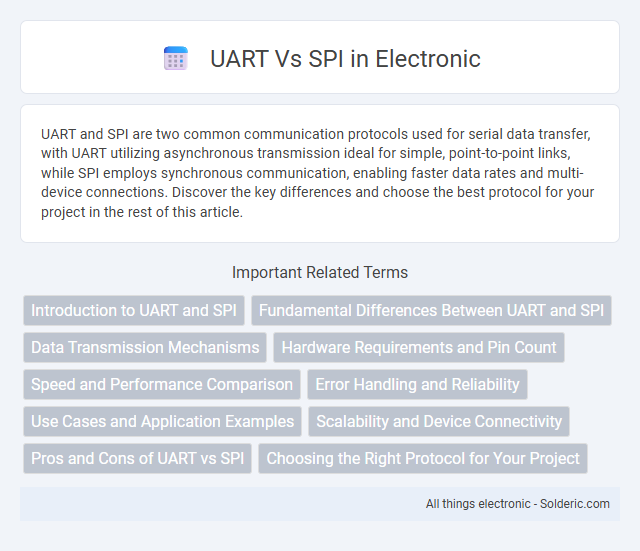UART and SPI are two common communication protocols used for serial data transfer, with UART utilizing asynchronous transmission ideal for simple, point-to-point links, while SPI employs synchronous communication, enabling faster data rates and multi-device connections. Discover the key differences and choose the best protocol for your project in the rest of this article.
Comparison Table
| Feature | UART (Universal Asynchronous Receiver/Transmitter) | SPI (Serial Peripheral Interface) |
|---|---|---|
| Communication Type | Asynchronous serial | Synchronous serial |
| Number of Wires | 2 (TX, RX) | 4 (MOSI, MISO, SCLK, SS) |
| Speed | Up to 1 Mbps (typical) | Up to several Mbps (10+ Mbps common) |
| Data Transfer | Full duplex | Full duplex |
| Data Frame | Start bit, data bits, parity, stop bits | Configurable word size (usually 8 bits) |
| Clock | Not required (self-timed) | Required (SCLK line) |
| Master/Slave | No master/slave, peer-to-peer | Master-slave architecture |
| Typical Usage | Simple serial communication, long distance | High-speed peripheral communication, short distance |
| Complexity | Lower, easier to implement | Higher, more complex wiring |
| Hardware Requirements | Minimal, often built into microcontrollers | Requires dedicated SPI controller or peripheral |
Introduction to UART and SPI
UART (Universal Asynchronous Receiver/Transmitter) and SPI (Serial Peripheral Interface) are two widely used communication protocols in embedded systems for data exchange between microcontrollers and peripherals. UART operates using asynchronous serial communication with start and stop bits, ideal for long-distance communication with minimal wiring. SPI uses synchronous serial communication with separate clock, data, and chip select lines, providing faster data transfer rates and full-duplex communication for short-distance applications.
Fundamental Differences Between UART and SPI
UART (Universal Asynchronous Receiver/Transmitter) operates as a serial communication protocol using two wires for transmission and reception, relying on asynchronous communication without a clock signal. SPI (Serial Peripheral Interface) uses a synchronous communication method with four wires, including clock, master out slave in (MOSI), master in slave out (MISO), and chip select (CS), allowing full-duplex data transfer. Your choice between UART and SPI depends on the required communication speed, complexity, and whether synchronous or asynchronous data exchange best suits your device interface needs.
Data Transmission Mechanisms
UART transmits data asynchronously using start and stop bits to frame each byte, allowing for simple point-to-point communication over two wires (TX and RX). SPI operates synchronously with a clock signal and separate lines for master output, slave input (MOSI), master input, slave output (MISO), and a chip select, enabling full-duplex data exchange with higher speeds. The synchronous clock in SPI provides precise timing, minimizing errors and supporting multiple devices on a single bus, unlike UART's simpler but slower asynchronous method.
Hardware Requirements and Pin Count
UART requires only two pins for communication--one for transmission (TX) and one for reception (RX)--making it ideal for simple, low-pin-count applications. SPI necessitates at least four pins: MOSI (Master Out Slave In), MISO (Master In Slave Out), SCLK (Serial Clock), and SS (Slave Select), supporting higher data rates but with increased hardware complexity. Your choice depends on whether minimal hardware or faster, full-duplex communication with multiple devices is a priority.
Speed and Performance Comparison
SPI offers significantly higher data transfer speeds than UART, often reaching up to tens of Mbps compared to UART's maximum of around 1 Mbps. SPI supports full-duplex communication, enabling simultaneous send and receive operations that enhance overall performance, whereas UART operates in half-duplex mode. Your choice between UART and SPI should consider the required data throughput and complexity of the communication setup for optimal system performance.
Error Handling and Reliability
UART employs parity bits and stop bits for basic error detection, offering moderate reliability in low-noise environments. SPI lacks inherent error detection mechanisms but can achieve higher reliability through dedicated hardware protocols and CRC checks implemented by the user. For applications requiring robust error handling, UART provides simpler built-in solutions, whereas SPI demands external error management to ensure data integrity.
Use Cases and Application Examples
UART (Universal Asynchronous Receiver/Transmitter) is widely used in serial communication for low-speed, short-distance data exchange such as GPS modules, Bluetooth devices, and microcontroller debugging interfaces. SPI (Serial Peripheral Interface) excels in high-speed, short-distance communication between microcontrollers and peripherals like sensors, flash memory, and display modules due to its full-duplex capability and higher data rates. Common applications of SPI include interfacing with SD cards and LCD screens, while UART is favored in RS-232 communication and serial ports for simple, point-to-point connections.
Scalability and Device Connectivity
SPI offers superior scalability for connecting multiple devices due to its separate slave select lines, allowing you to manage numerous peripherals with precise control. UART typically supports only point-to-point communication, limiting its device connectivity in complex systems. For extensive device networks and flexible expansion, SPI is the preferred protocol.
Pros and Cons of UART vs SPI
UART offers simplicity and ease of implementation with only two communication lines, making it ideal for serial communication over longer distances but is limited by lower data transfer rates and no clock signal for synchronization. SPI provides high-speed data transfer with full-duplex communication and flexible multi-slave connections through dedicated chip select lines, yet it requires more pins and increased complexity in wiring and software management. Your choice between UART and SPI depends on the specific requirements for data speed, distance, and hardware complexity in your project.
Choosing the Right Protocol for Your Project
UART offers simple, point-to-point communication ideal for low-speed data transfer and minimal wiring, making it suitable for serial communication between two devices. SPI supports higher data rates with full-duplex communication and multiple slave devices, perfect for applications requiring fast, synchronous data exchange and complex device networks. Your choice depends on factors like data speed, device count, wiring complexity, and protocol overhead, with SPI favored for speed and multiple peripherals, while UART excels in simplicity and ease of implementation.
UART vs SPI Infographic

 solderic.com
solderic.com